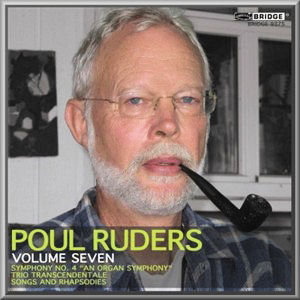 |
 |
|


alternatively
CD: MDT
AmazonUK
AmazonUS
|
Poul RUDERS (b.1949)
* Symphony no.4 (An Organ Symphony) (2008) [29:05]
+ Trio Transcendentale, for organ (2010) [4:32]
# Songs and Rhapsodies, for accordion and winds (2011)
[27:11]
 *Flemming Dreisig (organ); *Odense Symphony Orchestra/ *Robert Minczuk;
+Nicholas Wearne (organ); #Frode Andersen (accordion); #Athelas
Sinfonietta Copenhagen
*Flemming Dreisig (organ); *Odense Symphony Orchestra/ *Robert Minczuk;
+Nicholas Wearne (organ); #Frode Andersen (accordion); #Athelas
Sinfonietta Copenhagen
rec. *+Carl Nielsen Concert Hall, Odense, 10-11 June 2011; #Dinesen,
Copenhagen, 7-8 June 2011. DDD
 BRIDGE RECORDS 9375 [60:48]
BRIDGE RECORDS 9375 [60:48]
|
|
|
This is volume 7 of Bridge's laudable series devoted to the 'Music of Poul Ruders'. Volume 6 was released last year - see review. Details of all previous volumes are included in the accompanying booklet.
The CD opens with Ruders' ambitious Fourth Symphony,
the obbligato organ part performed by the delightfully-named
Flemming Dreisig in the Carl Nielsen Concert Hall in Odense.
This unusually 'bottom-heavy' work begins with
a gentle, ambiguous first movement, the booklet notes suggesting
rather fancifully "a Nordic landscape under brooding storm
clouds". The 'Cortège' second movement builds
the volume and pace slowly but surely, yet not in any predictable
direction - Ruders is rarely predictable! The movement ends
suddenly and then bursts back into life with a short but frenetic
presto 'Etude', a scherzo of diabolic intensity
that examines the whole orchestra. The finale is an epic 'Chaconne',
in Ruders' words "no holds barred". Here the
Odense Symphony Orchestra is in scintillating form under Roberto
Minczuk, who conducted the Dallas Symphony in the work's
2010 premiere performance. But it is Dreisig who really earns
his fee in the final tumultuous pages of this surprisingly approachable,
highly memorable work, as Ruders lets rip with a saturnalia
to blow the church roof off.
Ruders wrote the Trio Transcendentale - which, if a French title, he or Bridge has given a grammatically wayward feminine -e suffix - as a test piece for organ for the 2011 Carl Nielsen Competition. It begins in jolly mood with what he describes as "popcorn Baroque" but ends up, after a short eerie interlude, in tonal bedlam. Needless to say it really does test the organist's dexterity and pedal power, but for the listener it is a diverting piece to follow the seriousness of the Symphony. The competition section winner was Nicholas Wearne, who performs it here with aplomb.
The final work, Songs and Rhapsodies, was written for accordionist Frode Andersen, who gave the premiere performance last year, shortly before this recording was made. There are twelve short sections, with movements 2, 4, 6 and 10 labelled 'Rhapsody', the remaining eight variously-titled, but always melodic - the 'Songs', of course. The accordion is accompanied by a wind quintet drawn from the Athelas Sinfonietta playing nine different instruments for maximal utilisation of sonorities, although the work is, for Ruders at least, not especially exploratory. It ends, appropriately, with a 'Swan Song', but the 'Stratospheric Solo' for unaccompanied accordion that directly precedes it may leave the listener feeling temporarily struck down with tinnitus! Ruders writes very imaginatively for the accordion, as his oddly-titled but absorbing Serenade on the Shores of the Cosmic Ocean on volume 6 has already shown.
Volume 6 was actually marred by the especially poor recording of Bel Canto, a fact which completely escaped the critical ear of at least one eminent magazine, which completely unjustifiably short-listed it for a contemporary music award. On this disc, in any case, Bridge revert to their usual high standards, although even here there is some minor distortion in the loudest, deepest organ tutti chords in the Symphony. In fairness that kind of thing is a challenge for any sound engineer.
The English-only CD booklet is informative, with intelligent notes in plain language by the ever-dependable Malcolm MacDonald. There are decent biographies and a few black-and-white Seventies-feel photos of the performers with Ruders. On the front cover Ruders once again flouts health and safety regulations by appearing with his trademark pipe in mouth - although it does appear to be unlit.
Byzantion
Collected reviews and contact at reviews.gramma.co.uk
|
|

